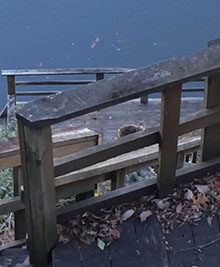Coyote Control Using Hazing
 Coyotes are often misunderstood, as they can help control other rodent and wildlife problems. They truly are nature’s animal control officers. Ironically, in the past 20 years, we’ve witnessed a dramatic reversal of the encroachment process and coyotes are actually encroaching on our habitat in urban neighborhood areas across the nation and they are doing so at an unprecedented rate. Most urban areas, we have created safe, suitable habitat for other wildlife including coyotes. They aren’t forced to live among us, they take the opportunity to live among us with the unlimited availability of food and shelter. All coyotes are not bad, but just like if you have a squirrel in your attic, it does not warrant capture of all the squirrels in the area. However removal of the problem animal that has developed that natural behavior pattern is key for a solution. Frequent pet attacks in a urban area by a coyote will not forget or loose the behavior pattern that pets are easy prey. This is why it is important to really understand that hazing is often ineffective solution in the control of coyotes. Can hazing help in some situations, sure, but I wouldn’t believe the misinformation that it causes coyotes to leave a area. Most Coyote Management Plans where hazing is used often have the same results, as coyotes will get used to hazing techniques, as they find they are little to no threat, and will become slower to respond to hazing. Contact a Animal Pros coyote control specialist for a consultation in dealing with coyote conflicts.
Coyotes are often misunderstood, as they can help control other rodent and wildlife problems. They truly are nature’s animal control officers. Ironically, in the past 20 years, we’ve witnessed a dramatic reversal of the encroachment process and coyotes are actually encroaching on our habitat in urban neighborhood areas across the nation and they are doing so at an unprecedented rate. Most urban areas, we have created safe, suitable habitat for other wildlife including coyotes. They aren’t forced to live among us, they take the opportunity to live among us with the unlimited availability of food and shelter. All coyotes are not bad, but just like if you have a squirrel in your attic, it does not warrant capture of all the squirrels in the area. However removal of the problem animal that has developed that natural behavior pattern is key for a solution. Frequent pet attacks in a urban area by a coyote will not forget or loose the behavior pattern that pets are easy prey. This is why it is important to really understand that hazing is often ineffective solution in the control of coyotes. Can hazing help in some situations, sure, but I wouldn’t believe the misinformation that it causes coyotes to leave a area. Most Coyote Management Plans where hazing is used often have the same results, as coyotes will get used to hazing techniques, as they find they are little to no threat, and will become slower to respond to hazing. Contact a Animal Pros coyote control specialist for a consultation in dealing with coyote conflicts.
“Active” Coyote Hazing Methods
“Hazing” methods both “Passive” and “Active” hazing for control of coyotes includes habitat modification, visual and sound action deterrents to discourage coyote activity in urban areas. Actions, sounds, and items, are used to maintain the natural “fear of humans” in the coyote. Hazing Methods include:
- Making yourself appear large and yelling at a coyote.
- Waiving your arms and shouting at a coyote.
- Hitting a stick or cane against the pavement to scare a coyote.
- Approaching a coyote.
- Using your voice or a whistle to scare a coyote.
- Using pepper spray to deter a coyote.
Coyote Hazing methods often fall short as a effective solution as we are dealing with residential coyotes that are used to the presence of people, the presence of noise, and coyotes that are very familiar in the area they live. With the abundant availability of food, wildlife, and shelter in residential areas, why would they leave. Hazing will not work if the coyote is at a distance as there is no threat. Hazing can even be a liability if the coyote is sick, injured, or diseased, as they can act outside of normal behavior.
“Passive” Coyote Hazing Methods
Passive coyote hazing methods can be more effective at coexisting with coyotes. These methods avoid active interaction with coyotes and offer a more common sense approach. Passive hazing methods for controlling coyotes include:
- Habitat Modification for coyote control.
- Thinning vegetation around property.
- Eliminating compost piles as it will attract coyotes.
- Eliminating feeding wildlife and feeders, as it will keep coyotes in the area.
- Avoiding feeding pets outdoors.
- Perimeter fencing added around your property.
- Keeping a eye on pets at all times.
These passive hazing control methods will have a longer, more successful impact in coexisting with coyotes. The fact is coyotes will always be around, and there are steps that can be taken to curb coyote activity, and it does involve education and management long term. There is misinformation on coyotes and control out there, that Hazing alone will magically fix all coyote problems, and the truth is for a long term solution, management goals for coyote control is to bring activity down to a acceptable level, and implement effective methods that offer education to the public, offer homeowners help, reduce coyote conflicts, and manage populations in urban areas. For expert advice in controlling coyotes contact a Animal Pros specialist today.
